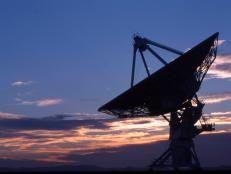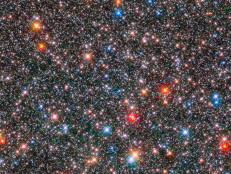SPACE OUT with Paul M. Sutter
All SPACE OUT Articles
Showing 76 - 90 of 153 results
Top 5 Reasons Why the “UFO Report” Isn’t Interesting to me, a Scientist
Excited by the prospects of the “UFO Report”? As a scientist, I have my doubts. But you can watch UFOS DECLASSIFED: LIVE on Discovery and Science June 30 at 8P where experts discuss what can and can't be explained.
Small Galaxies Matter Too
Long ago, our universe was without stars. When that first generation ignited, it completely transformed the cosmos, ripping away the veil of neutral gas that had persisted for hundreds of millions of years. This process, called reionization, is largely mysterious to astronomers. But new research is revealing that the smallest of galaxies may have played the biggest of roles.
Is Interstellar Travel Really Possible?
Listen folks, I love a good sci-fi movie as much as anyone. Cruising around the galaxy, finding weird stuff, and blowing up aliens--it’s all good. But just because a writer can come up with something, it doesn’t make it possible. I’m sorry to say that we’re going to be bound to our solar system for a really, really long time. As in, probably forever.
Want to See a Black Hole’s Magnetic Field? Now’s Your Chance
A couple years ago, the team of astronomers with the Event Horizon Telescope wowed the world by providing our first-ever snapshot of a real-life black hole. Now they’ve done one better and mapped out the swirling magnetic fields around the monster. It’s our first ever glimpse of the forces that power the largest engines in the universe.
What Is a “Super Earth” and Why Do We Care?
Super Earths are super cool, and you should really know about them. In short, they are planets slightly bigger than the Earth (hence the name). And the cool part? They might be a home for life, and they’re way easier to study than regular Earths.
When and Where is the Chinese Rocket Falling Back to Earth?
What goes up, must come down. On April 28th, a Chinese Long March 5B rocket went up, successfully delivering its payload, a new section of the Tianhe space station, into orbit. But now the 21-ton rocket is coming down, uncontrolled.
It's Time for a 2021 Space Flight Round-up
Space is a busy place, with a lot of things going up (most of the time) and coming down (when we want them to). Let’s check in on the latest orbital happenings.
How to Make a Neutron Star at Home
First, take a bunch of matter. It doesn’t matter what kind – a piece of paper, some leftover gum. Then, press it, and press it, and press it some more. Don’t stop now! We’ve got a long way to go.
How Common are Water Worlds in the Galaxy?
If Kevin Costner wanted to make a sequel, he’s got plenty of opportunities. Water is by far the most common molecule in the universe. It’s made of two parts hydrogen and one part oxygen. Hydrogen is element number 1 (both on the period table and in abundance), and has been hanging around since the first 15 minutes of the Big Bang. Oxygen is forged in the hearts of sun-like stars, and spreads around when those stars die and turn themselves inside out. And since sun-like stars are also very popular, oxygen gets quite a boost.
It’s Time to Return to the Land of the Ice Giants
30 years--It’s been over 30 years since the Voyager 2’s historic flyby of Uranus and Neptune, the outermost and most mysterious planets in the solar system. It’s time to go back.
Why Charting the Most Extreme Objects in the Solar System Matters
So the astronomers called it “FarFarOut”, which is mostly a joke because the last time they found such a distant object it they nicknamed it “FarOut”, and this new world is much, much, farther out.
The New Warp Drive Idea Isn’t Very Warpy
Headline after headline is sharing the exciting news: a pair of theoretical physicists have realized that our sci-fi dreams may be real: it may be possible to build an actual, operational warp drive. One problem: it doesn’t go all that fast.
The Top 5 Weirdest Moons of the Solar System
From the exotic to the just plain odd, our solar system is home to some of the most extreme worlds in the galaxy. But I’m not talking about the planets, I’m talking about their moons. Let’s take a look at the most strange...
A Eulogy for a Galaxy
ID2299, a galaxy 13.8 billion light years away, died far too young.
Like Stars? How About 6 in the Same Solar System?
Meet TYC 7037-89-1, a six-star solar system. Astrophysicist Paul M. Sutter explains this stellar surprise discovery.


























